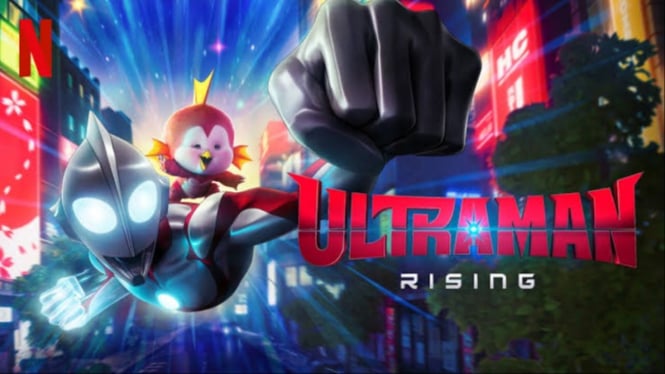Ultraman's Western Journey: From Margins to Mainstream with "Ultraman: Rising"
 |
| Ultraman's Western Journey: From Margins to Mainstream with "Ultraman: Rising" (Pics: Viva.co.id) |
WATCHFILM.BIZ.ID - Ultraman, a cultural icon in Japan for 58 years, has struggled to find a significant foothold in Western culture. Despite its enduring popularity in Japan, Ultraman's influence in the West has been minimal, with only a few notable mentions: Marvel Comics adaptations, an inspiration for Ant-Man's costume in the Marvel Cinematic Universe, and a humorous reference in the animated TV series South Park.
However, Ultraman is finally receiving the Hollywood treatment through the Netflix original film Ultraman: Rising. This film marks a charming, if somewhat safe, entry into the superhero genre.
A New Dawn for Shannon Tindle
Ultraman: Rising also signifies a pivotal moment for Shannon Tindle, who makes his feature directorial debut with this film. Tindle is no stranger to the animation industry, having worked as an animator, character designer, and writer on beloved projects such as Coraline and Kubo and the Two Strings, as well as animated series like Foster’s Home for Imaginary Friends and The Fairly OddParents.
Initially, Tindle developed the concept as an original story titled "Big in Japan" at Sony Pictures Animation. When that project stalled in 2018, he retooled the concept under the Ultraman IP, collaborating with Netflix Animation and Tsuburaya Productions to bring the film to life.
Animation Excellence by Industrial Light & Magic
Handling the animation for Ultraman: Rising is Industrial Light & Magic (ILM), renowned for their work on Rango with director Gore Verbinski and the 2022 live-action hybrid Netflix series Lost Ollie, also involving Tindle.
This strong relationship enhances Ultraman: Rising, infusing Tindle's vision for Tokyo-set kaiju battles with technical prowess. The film's standout moments are grounded in the personal stakes of the story, creating an emotional core that resonates more deeply than mere explosive action.
The Story of Ultraman: Rising
In this iteration, Ultraman follows the journey of baseball star Ken Sato (voiced by Christopher Sean). Sato struggles to balance his life as a celebrity athlete with the newfound responsibilities of being Ultraman, a legendary hero previously upheld by his father. Sato's life takes an unexpected turn when he must care for Emi, a 35-foot-tall, fire-breathing baby kaiju, the offspring of his greatest foe.
Despite Emi’s formidable exterior, she is essentially a cute, needy water dragon. Sato must navigate the challenges of parenthood while protecting Emi from a government intent on eradicating all giant monsters in Tokyo.
Co-writers Marc Haimes (Nimona, Lost Ollie) and Shannon Tindle craft a classic superhero narrative. They pile on multiple layers of responsibility for Sato: his duties as an athlete, a superhero, a father, and a son to Professor Sato (voiced by Gedde Watanabe).
This intricate setup challenges Ultraman: Rising to operate on both grand and intimate scales. The hyper-stylized CG animation by ILM, featuring flashes of 2D effects, excels in large-scale setpieces, making the film visually compelling.
The Unique Animation Style
Directors Shannon Tindle and John Aoshima (Gravity Falls, DuckTales) employ a unique animation style to represent Ultraman's powers. They shift entire environments to convey the impact of Ultraman's punches, whisking viewers away from Tokyo into a world of colorful speed lines.
This creative choice highlights Ultraman’s abilities through tactile visuals rather than burdensome dialogue, achieving a core pillar of superhero films: making powers look not just cool but spectacular.
The epic battles, especially between Ultraman and a giant robot above Tokyo's skyline, are rendered with sleek, dynamic animation that keeps adrenaline levels high.
Balancing Action and Emotion
ILM’s animation also shines in the portrayal of Emi, the baby kaiju. They capture human-like expressions of joy, anger, and angst, mapped onto Emi in a charming and humorous way. However, the film's art style faces challenges in quieter moments.
Human characters sometimes exhibit exaggerated movements that detract from the natural feel of their interactions. Subtlety is crucial in these scenes, but the characters' over-the-top physicality can feel out of place.
Voice acting performances, while engaging, occasionally fall into the trap of over-explanation common in Western animation. This tendency to summarize the action for clarity can make characters feel less human.
Despite these quirks, Ultraman: Rising succeeds in giving Ken Sato a satisfying character arc. His journey from isolation to building genuine connections is emotionally rewarding, enhancing the film's climax.
Final Thoughts
Ultraman: Rising provides a solid, stable introduction of Ultraman to Western audiences. It’s a charming, funny, and visually appealing film, though it does not entirely escape the tropes of Western animation. While younger viewers will find much to love, Shannon Tindle’s version of Ultraman deserves room to grow beyond being a safe crowd-pleaser.
Western animation thrives on creatives taking risks, and Netflix's Ultraman franchise has the potential to be another example of this trend. The fresh ideas and unique blend of CG and 2D animation in Ultraman: Rising are visually captivating. Ken Sato’s relationship with kaiju, which he seeks to both defeat and preserve, offers an intriguing dynamic.
Although the film touches on darker themes of loss, these ideas are not fully realized in the final product. With time and opportunity, future installments can explore these depths, allowing Ultraman to truly rise in the West.











Post a Comment
0 Comments